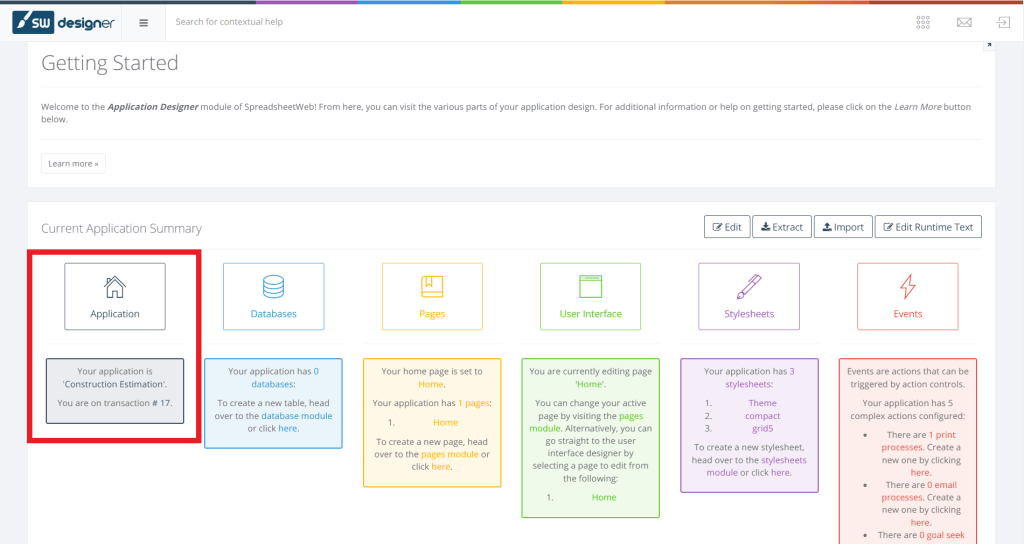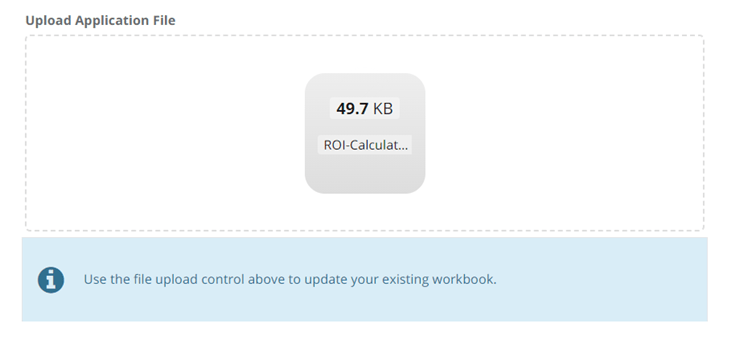Application

Application page is where one can find information about their application and can update their application. Application page can be utilized to modify settings that are specific to the web application. The screen is available through pressing Edit on the Designer Home Page. Application page includes three sections:
Edit Existing Settings
This section lets users edit existing settings of the designer application.

Upload New Workbook
From th the underlying Excel model for the application that includes all information for the application can be updated. In order to update the workbook, simply click on the ‘Click Here’ button then select or drag and drop the updated Excel file by clicking on the Spreadsheet File drop zone.

Upon updating the model and pressing the Update button located at the end of the page.

All of the named ranges will be updated and SpreadsheetWeb’s internal system validation will run to ensure that the new model is compatible with the existing user interface, database, and page design. If there are any incompatibilities, the system will redirect user to the Validation Messages screen, where these issues will be further detailed. PS: Updating the Excel model from the design mode will not affect any published versions of the application. The published version will continue to utilize your existing calculation engine until the new version is published, at which point the new Excel model will be the production version. However, the I/O changes from the Excel model will be applied to the designer components themselves (e.g., user interface, page, and database designer will reflect updated named ranges), as well as within the preview of the current transaction (i.e., previewing the transaction will use the new Excel model for calculations).
Enable Google Analytics
SpreadsheetWeb also supports Google Analytics for Designer Applications. In order to use it, Enable Google Analytics checkbox needs to be to checked and the tracking ID must be entered into the Google Analytics Key input. A new tracking ID for the application can be retrieved by using the Google Analytics control panel. The domain address of the application should be entered correctly in order for Google Analytics to function as expected. After the application is saved and published, application’s hits from the Google Analytics tracking site can be monitored. 
Colors
Designer applications can be configured to use different color sets in visualizations, i.e. charts, and maps. The desired color set can be set by clicking Edit Default Colors button. Color manager window will allow to select a color set from the pre-defined sets. Also, a desired color set can be chosen too. 

Culture
Designer applications support different Culture settings which can be used to set how the thousands and decimal separators will be shown. 
Auto-Save
Auto-Save feature allows to save data periodically during the user session in case the user forgets to hit Save button manually. To be able to see and use the Auto-Save feature, you must have databases defined for your application and a save button present somewhere in your user interface.

Enabling Auto-Save flag will make two additional options visible: Auto-Save Should Use Properties from Following Button and Auto-Save Interval.
The Auto-Save Should Use Properties from Following Button field is a dropdown, where you may select from the buttons that are present somewhere in your user interface. These buttons do not need to be visible or enabled to be selected. The purpose of this value is that the auto-save feature will mimic the usage of this button when performing the save action. This means you do not need to reconfigure all of the save-specific features, such as your tag saving behaviors or custom action triggers, to enable auto-save.
The Auto-Save Interval determines how often the auto-save should trigger. This measure is shown in hours (e.g., 01:00 would equate to once every hour, whereas 00:01 would be once per minute). This value is required for auto-save to function.
Enable Record Locking
If your designer application has Save Event, Enable Record Locking feature will help to lock a record to other users while another user is editing it. ![]()
Inactive Record Locking Timeout
If Enable Record Locking is enabled, this value can be set with following format “hh:mm”. Setting this value means that a record will be locked for the selected duration for other users but for the user which opened the record first. 
Enable Record Suggestion
There are cases where you may want the user to be prompted as to whether they would like to continue editing a record that they were previously working on the last time that they were in the particular application.
To accommodate this feature, we have enabled the Enabled Record Suggestions functionality. When a user creates or edits a record under an application, that information will be stored. The next time that the user enters the application without selecting a record from Data tab, the system will prompt them with a message, indicating that the last time they were here, they were editing a record, and ask whether they would like to return to continue editing that record.
This only works with authenticated users. If – for some reason – the record that the user was originally working on is no longer accessible to that user (e.g., the tags have changed, resulting in it no longer be accessible), then the user will not be prompted with the feature.

Prompt User Confirmation on Log Out
Enabling this feature will ask for a confirmation from the user before logging out of the application. By using this feature, users can reduce the risk of logging out from the application with unsaved data. 

Access Type
Access Type control allows users to set their application as ” Restricted” or “Unrestricted”. Unrestricted Applications are publicly available which means that anyone who has the application link can access it. Restricted Applications can only be accessed by registered users.
Upload Favicon
The Favicon allows users to modify the associated icon that shows up in the tab of the user’s browser. To upload a favicon, click on edit then select an image to upload or simply drag and drop your favicon into the drop zone. Once the file has been successfully uploaded, you can press the Upload button to save the favicon for your application. PS: The permitted format for favicon images is *.ICO, which can be generated using a standard image and any number of web-based or desktop-based image editing tools.
![]()
Upload Branding Image
This feature allows users to modify the image that is displayed in the navigation bar of the application. To edit navigation bar branding, click on edit then select an image to upload or simply drag and drop an image into the drop zone. Once the file has been successfully uploaded, you can press the Upload button to save the navigation bar branding for your application. PS: The permitted formats for branding images are *.PNG, *.JPEG, *.JPG, *.GIF, and *.SVG, which can be generated using a standard image and any number of web-based or desktop-based image editing tools.

Upload Background Image
This feature allows users to modify the image that is displayed on the background of all pages in your web application. To edit the background image, click on edit then select an image to upload or simply drag and drop an image into the drop zone. Once the file has been successfully uploaded, you can press the Upload button to save the background image for your application.

PS: The permitted formats for background images are *.PNG, *.JPEG, *.JPG, and *.GIF, which can be generated using a standard image and any number of web-based or desktop-based image editing tools. Please make sure that your image file is under 2MB in size.
